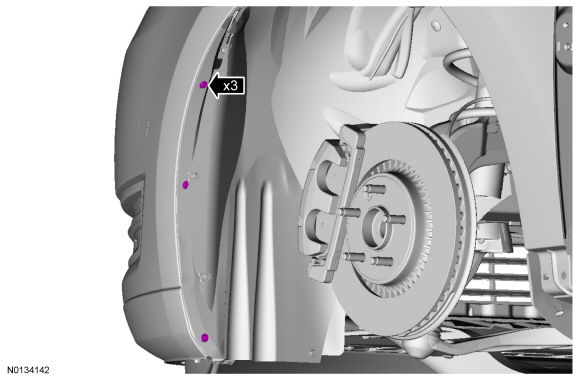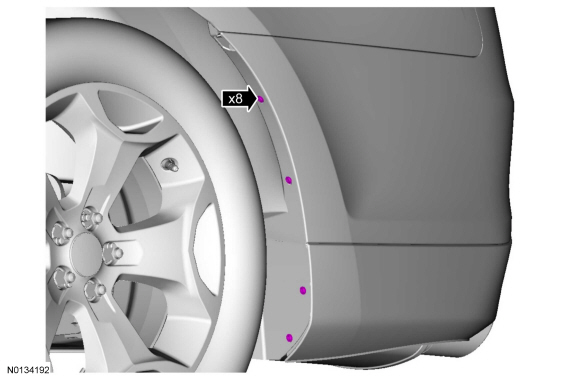SPECIFICATIONS
Torque Specifications

REMOVAL AND INSTALLATION
Bumper Cover - Front
Removal
- With the vehicle in NEUTRAL, position it on a hoist. For additional information, refer to Section 100-02.

- NOTE: Three on each side.


- NOTE: If equipped.

- NOTE: If equipped.

- NOTE: One on each side.

- NOTE: The rearward upper portion of the bumper cover must be pulled outward and downward to unclip it from the fender.

- If necessary, install new bumper cover mounting brackets.

Installation
- To install, reverse the removal procedure.
Bumper - Front
Removal
- Remove the front bumper cover. For additional information, refer to Bumper Cover - Front.
- If equipped, remove the active grille shutter assembly. For additional information refer to Section 501-02.
- NOTE: The removal of the speed control sensor or the cruise
control sensor bracket will require vertical alignment of the cruise control
sensor and Cruise-Control Module (C-CM) Calibration when reinstalled.
If equipped, remove the cruise control sensor and bracket. For additional information, refer to Section 413-13B.
- If equipped.
- To install, tighten to 8 Nm (71 lb-in).

- NOTE: There are 2 tack welds on each side of the front bumper. These welds must be drilled out to remove the beam.

- NOTE: Tack welds retaining the front bumper to the body rails are
not required for installation. Install new front bumper bolts.
- To install, tighten to 23 Nm (17 lb-ft).

Installation
- To install, reverse the removal procedure.
Bumper Cover - Rear
Removal
- With the vehicle in NEUTRAL, position it on a hoist. For additional information, refer to Section 100-02.
- Remove the rear taillamps. For additional information, refer to Section 417-01.


- NOTE: Four on each side.

- NOTE: On each side.

- NOTE: Pull upward beneath the tail lamps to release the bumper cover upper clips.

- NOTE: Inspect the lower back sheet metal for distortion.

- NOTE: If necessary, install new bumper cover mounting reinforcements before installation.

Installation
- To install, reverse the removal procedure.
Bumper - Rear
Removal
- Remove the rear bumper cover. For additional information, refer to Bumper Cover - Rear.
- NOTE: Inspect the rear bumper double-ended studs for damage. If
necessary, install new rear bumper double-ended studs.
NOTE: Anytime the rear bumper nuts are removed, it is necessary to re-tighten the rear bumper double-ended studs.
- Tighten the rear bumper nuts to 23 Nm (17 lb-ft).
- Tighten the rear bumper double-ended studs to 12 Nm (106 lb-in).

Installation
- To install, reverse the removal procedure.
 Removal and Installation
Removal and Installation
Roof Opening Panel - Exploded View
NOTE: The roof opening panel motor must be initialized when repairs
are carried out on any part of the roof opening panel system, including:
whenever the roof ...
Other materials:
MyKey
Programming/Changing Configurable Settings
Use the information display to access your configurable MyKey settings:
1. Switch the ignition on using an admin key. If your vehicle has
push-button start, place the intelligent access key fob into the backup
slot. The location of your backup slot is i ...
In-Vehicle Repair
Upper Intake Manifold
Removal
NOTICE: If the engine is repaired or replaced because of upper
engine failure, typically including valve or piston damage, check the intake
manifold for metal debris. If metal debris is found, install a new intake
manifold. Failure to follow these instructions c ...
Noise, Vibration and Harshness (NVH) - Diagnosis and Testing
Special Tool(s)
Diagnostic Theory
The shortest route to an accurate diagnosis results from:
system knowledge, including comparison with a known good system.
system history, including repair history and usage patterns.
condition history, especially any relationship to repairs or sudden
change ...

